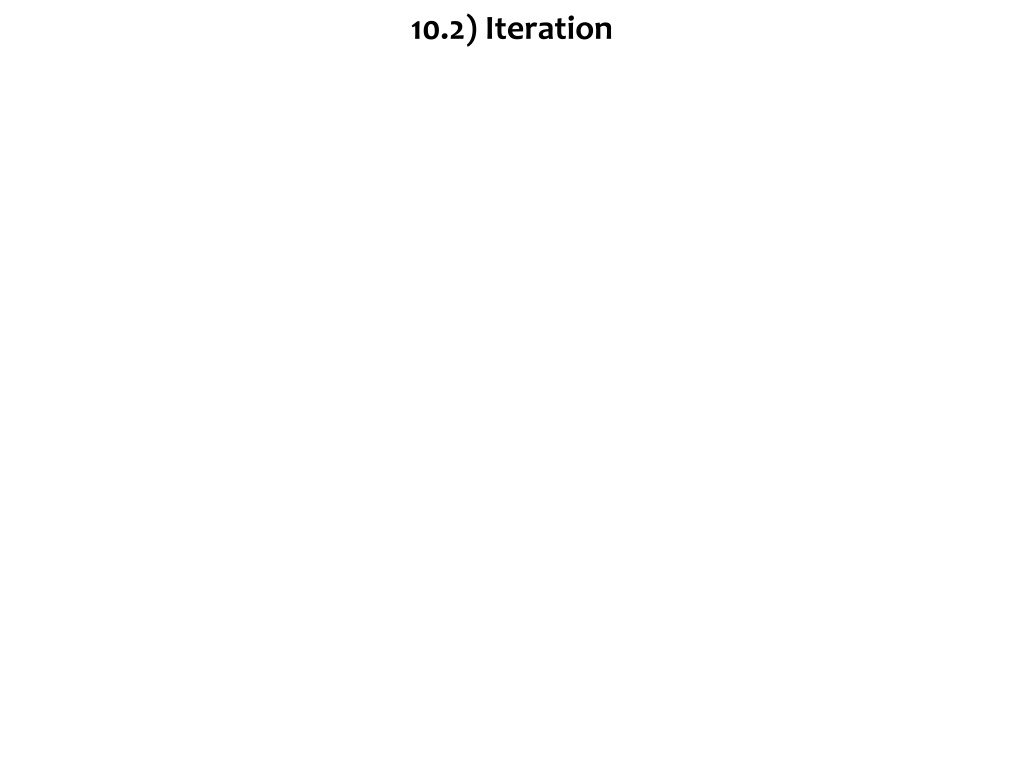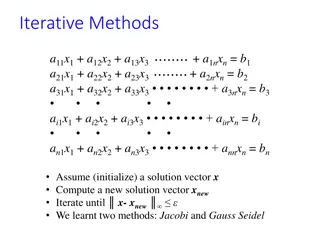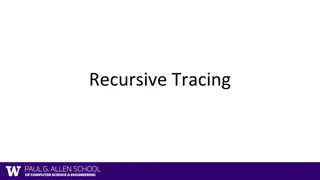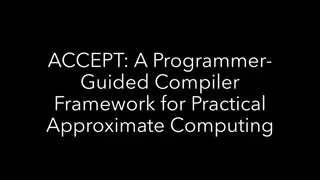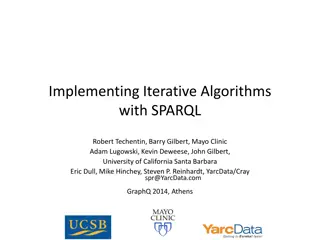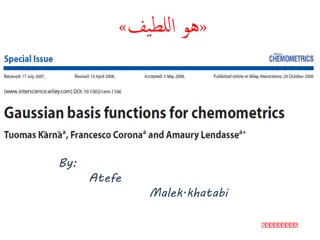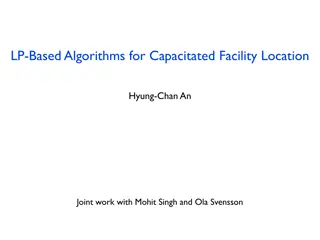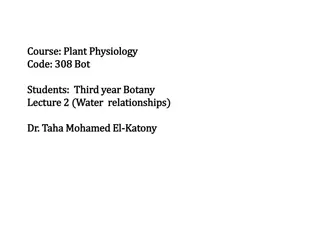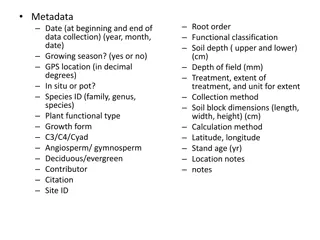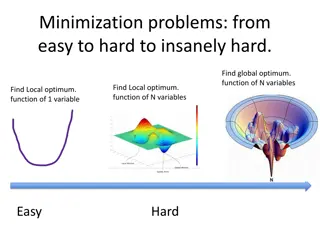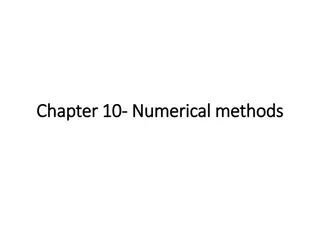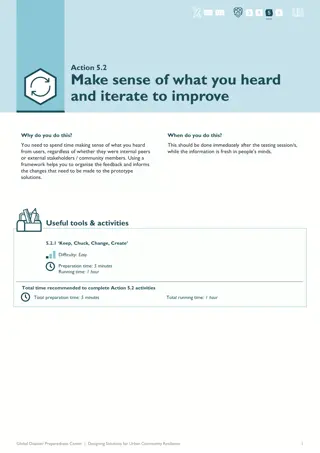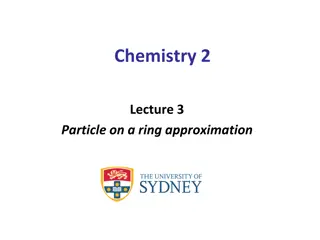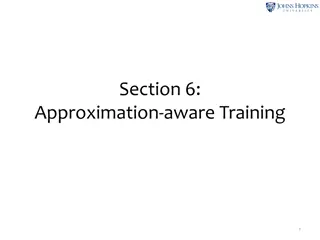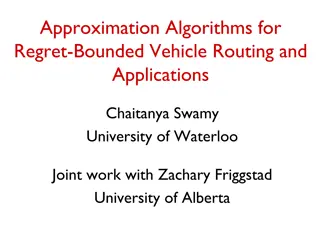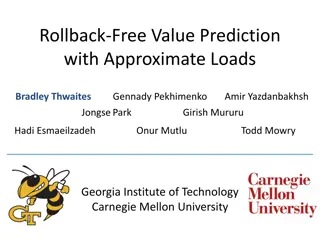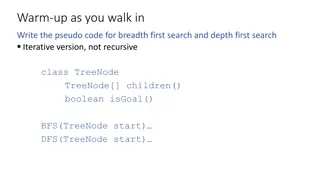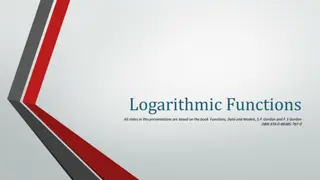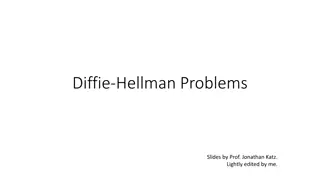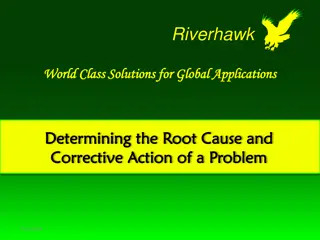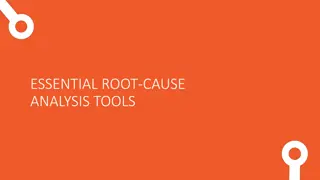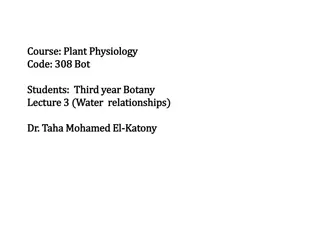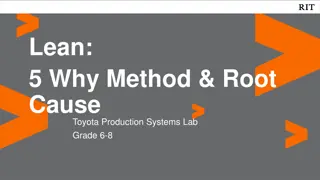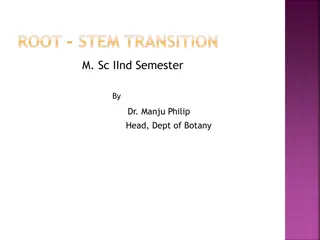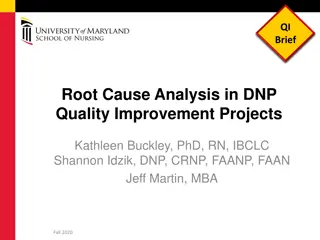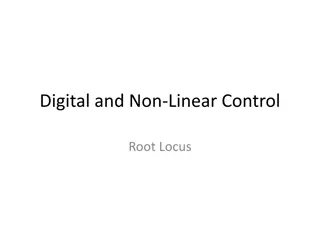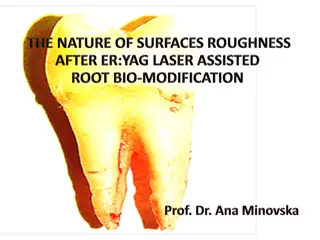Iterative Root Approximation Using Natural Logarithm
The content covers iterative root approximation using natural logarithm in solving equations. It explores finding roots by iterative formulas and demonstrates calculations to reach approximate values. The process involves selecting intervals to show correct values and ensuring continuity for accurate calculations.
Download Presentation

Please find below an Image/Link to download the presentation.
The content on the website is provided AS IS for your information and personal use only. It may not be sold, licensed, or shared on other websites without obtaining consent from the author. Download presentation by click this link. If you encounter any issues during the download, it is possible that the publisher has removed the file from their server.
E N D
Presentation Transcript
Your turn ? ? = ?2 6? + 2 Worked example ? ? = ?2 5? 3 a) Show that ? ? = 0 can be written as: i) ? =?2+2 6 ii) ? = a) Show that ? ? = 0 can be written as: i) ? =?2 3 5 ii) ? = 6? 2 iii) ? = 6 2 5? + 3 iii) ? = 5 +3 ? ? a) Shown
Your turn ? ? = ?2 6? + 2 Worked example ? ? = ?2 5? 3 a) Show that ? ? = 0 can be written as: i) ? =?2+2 6 ii) ? = b) Starting with ?0= 4 use each iterative formula to find a root of the equation ? ? = 0, rounding your answers to 3 decimal places a) Show that ? ? = 0 can be written as: i) ? =?2 3 5 ii) ? = b) Starting with ?0= 3 use each iterative formula to find a root of the equation ? ? = 0, rounding your answers to 3 decimal places 6? 2 iii) ? = 6 2 5? + 3 iii) ? = 5 +3 ? ? b) i) ? = 0.354 (3 dp) ii) ? = 5.646 (3 dp) iii) ? = 5.646 (3 dp)
Your turn ? ? = ?? 1+ ? 6 Worked example ? ? = ?? 2+ ? 5 a) Show that ? ? = 0 can be written as: ? = ln(6 ?) + 1, a) Show that ? ? = 0 can be written as: ? = ln(5 ?) + 2, ? < 6 ? < 5 a) Shown
Your turn ? ? = ?? 1+ ? 6 Worked example ? ? = ?? 2+ ? 5 a) Show that ? ? = 0 can be written as: ? = ln(6 ?) + 1, The root of ? ? = 0 is ?. The iterative formula ??+1= ln(6 ??) + 1, is used to find an approximate value for ? b) Calculate the values of ?1,?2 and ?3 to four decimal places. a) Show that ? ? = 0 can be written as: ? = ln(5 ?) + 2, The root of ? ? = 0 is ?. The iterative formula ??+1= ln(5 ??) + 2, is used to find an approximate value for ? b) Calculate the values of ?1,?2 and ?3 to four decimal places. ? < 6 ? < 5 ?0= 2 ?0= 3 b) ?0= 2 ?1= ln 6 2 + 1 = 2.3863 ?2= 2.2847 ?3= 2.3125
Your turn ? ? = ?? 1+ ? 6 Worked example ? ? = ?? 2+ ? 5 a) Show that ? ? = 0 can be written as: ? = ln(6 ?) + 1, The root of ? ? = 0 is ?. The iterative formula ??+1= ln(6 ??) + 1, is used to find an approximate value for ? b) Calculate the values of ?1,?2 and ?3 to four decimal places. c) By choosing a suitable interval, show that ? = 2.307 correct to 3 decimal places. c) ? 2.3065 = 0.00027 < 0 ? 2.3075 = 0.0044 > 0 Sign change and ? ? continuous in the interval [2.3065,2.3075] 2.3065 < ? < 2.3075 ? = 2.307 (3 dp) a) Show that ? ? = 0 can be written as: ? = ln(5 ?) + 2, The root of ? ? = 0 is ?. The iterative formula ??+1= ln(5 ??) + 2, is used to find an approximate value for ? b) Calculate the values of ?1,?2 and ?3 to four decimal places. c) By choosing a suitable interval, show that ? = 2.792 correct to 3 decimal places. ? < 6 ? < 5 ?0= 2 ?0= 3
Your turn Worked example ? ? = ?3 5?2 3? + 2 (a) Show that the equation ? ? = 0 has a root in the interval 5 < ? < 6. ? ? = ?3 3?2 2? + 5 (a) Show that the equation ? ? = 0 has a root in the interval 3 < ? < 4. (a) ? 3 = 1 < 0 ? 4 = 13 > 0 Change of sign and ?(?) continuous in the interval [3,4] root in the interval [3,4]
Your turn Worked example ? ? = ?3 5?2 3? + 2 (a) Show that the equation ? ? = 0 has a root in the interval 5 < ? < 6. (b) Use the iterative formula ? ? = ?3 3?2 2? + 5 (a) Show that the equation ? ? = 0 has a root in the interval 3 < ? < 4. (b) Use the iterative formula 3 2??+5 3 3 3??+2 5 ?? ?? ??+1= ??+1= to calculate the values of ?1, ?2 and ?3, giving your answers to 4 decimal places, and taking: (i) ?0= 1.5 (ii) ?0= 4 to calculate the values of ?1, ?2 and ?3, giving your answers to 4 decimal places, and taking: (i) ?0= 0.5 (ii) ?0= 6 (b) i) 1.53 2 1.5 + 5 3 ?2= 1.2544 ?3= 1.2200 Convergent as the change in the root on each iteration is decreasing. The iterative method will find the root. ?1= = 1.3385 ii) 43 2 4 + 5 3 ?1= = 4.5092 ?2= 5.4058 ?3= 7.1219 Divergent as the change in the root on each iteration is increasing. The iterative method has failed to find the root.
Your turn Worked example ? ? = ?3+ 4?2+ 3? 12 (a) Show that the equation can be written as ? ? = ?3+ 3?2+ 4? 12 (a) Show that the equation can be written as 4(3 ?) 3 + ? 3(4 ?) 4 + ? ? = ,? 3 ? = ,? 4 (a) Shown
Your turn Worked example ? ? = ?3+ 4?2+ 3? 12 (a) Show that the equation can be written as ? ? = ?3+ 3?2+ 4? 12 (a) Show that the equation can be written as 4(3 ?) 3 + ? 3(4 ?) 4 + ? ? = ,? 3 ? = ,? 4 The equation ? ? = 0 has a single root between 1 and 2. (b) Use the iterative formula The equation ? ? = 0 has a single root between 1 and 2. (b) Use the iterative formula 4(3 ??) 3+?? 4(3 ??) 3+?? ??+1= ,? 0,?0= 1 ??+1= ,? 0,?0= 1 to calculate the values of ?1, ?2 and ?3, giving your answers to 2 decimal places. to calculate the values of ?1, ?2 and ?3, giving your answers to 2 decimal places. (b) 4(3 1) 3 + 1 ?1= = 1.41 ?2= 1.20 ?3= 1.31
Your turn Worked example ? ? = ?3+ 4?2+ 3? 12 (a) Show that the equation can be written as ? ? = ?3+ 3?2+ 4? 12 (a) Show that the equation can be written as 4(3 ?) 3 + ? 3(4 ?) 4 + ? ? = ,? 3 ? = ,? 4 The equation ? ? = 0 has a single root between 1 and 2. (b) Use the iterative formula The equation ? ? = 0 has a single root between 1 and 2. (b) Use the iterative formula 4(3 ??) 3+?? 4(3 ??) 3+?? ??+1= ,? 0,?0= 1 ??+1= ,? 0,?0= 1 to calculate the values of ?1, ?2 and ?3, giving your answers to 2 decimal places. (c) The root of ? ? = 0 is ?. By choosing a suitable interval, prove that ? = 1.272 (3 dp) to calculate the values of ?1, ?2 and ?3, giving your answers to 2 decimal places. (c) The root of ? ? = 0 is ?. By choosing a suitable interval, prove that ? = 1.253 (3 dp) (c) ? 1.2715 = 0.00821 < 0 ? 1.2725 = 0.00827 > 0 Sign change and ? ? continuous in the interval [1.2715,1.2725] 1.2715 < ? < 1.2725 ? = 1.272 (3 dp)
Your turn Worked example Use the graph of ? = ? and ? = solve the equation ?2 ? 1 = 0 using the recurrence relation: ??+1= ? + 1 to Use the graph of ? = ? and ? = solve the equation ?2 ? 3 = 0 using the recurrence relation: ??+1= ? + 3 to ??+ 1,?0= 1 ??+ 3,?0= 1 Staircase diagram converging to root Graphs used with permission from DESMOS: https://www.desmos.com/
Your turn Worked example 1 3 Use the graph of ? = ? and ? = the equation ?2 ? 1 = 0 using the recurrence relation: Use the graph of ? = ? and ? = the equation ?2 ? 3 = 0 using the recurrence relation: ? 1 to solve ? 1 to solve 1 3 ??+1= ?? 1,?0= 2.5 ??+1= ?? 1,?0= 4.5 Cobweb diagram converging to root Graphs used with permission from DESMOS: https://www.desmos.com/
Your turn Worked example Use the graph of ? = ? and ? = ?2 1 to solve the equation ?2 ? 1 = 0 using the recurrence relation: ??+1= ?? Use the graph of ? = ? and ? = ?2 3 to solve the equation ?2 ? 3 = 0 using the recurrence relation: ??+1= ?? 2 1,?0= 2 2 3,?0= 3 Root approximations diverging iterative method fails Graphs used with permission from DESMOS: https://www.desmos.com/
